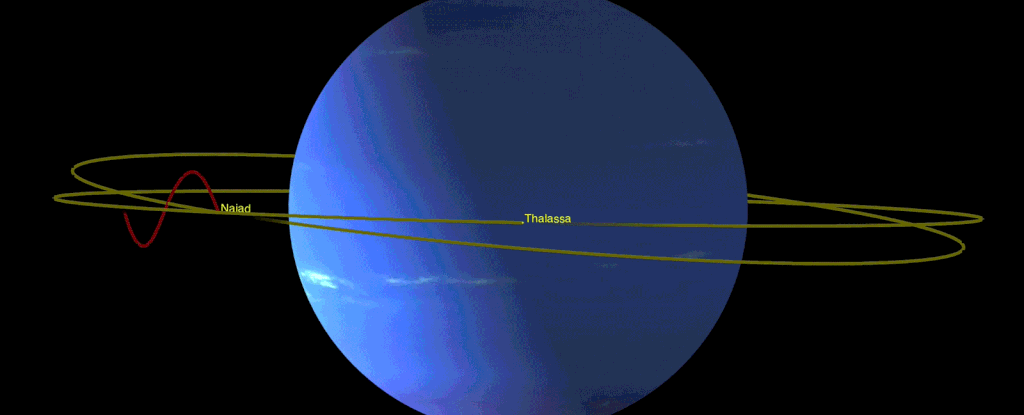Science
Related: About this forumNeptune's Moons Are Caught in One of The Strangest Orbits Ever Seen

DAVID NIELD10 JULY 2020
Life isn't always easy for astrophysicists: just when they've figured out another aspect of the patterns of movement in our Solar System, along come two of the moons of Neptune to mess everything up.
The two moons in question are Naiad and Thalassa, both around 100 kilometres or 62 miles wide, which race around their planet in what NASA researchers are calling a "dance of avoidance".
Their strange orbit was first detected by NASA researchers in November 2019.
Compared with Thalassa, Naiad's orbit is tilted by about five degrees – it spends half of its time above Thalassa and half of it below, in a linked orbit that's unlike anything else on record.
More:
https://www.sciencealert.com/neptune-s-moons-are-caught-in-one-of-the-strangest-orbits-ever-seen
NBachers
(17,122 posts)Is it possible that this orbit is more spiral than just flat up and down?
Judi Lynn
(160,545 posts)A weird, orbital dance keeps these moons of Neptune safely on track
By Erika K. Carlson | Published: Tuesday, November 19, 2019

This animation illustrates the wave pattern orbit of Neptune's moon Naiad's, which keeps it stable so close to the orbit of another moon, Thalassa.
NASA/JPL-Caltech
Bobbing up and down like a carousel horse might not sound like a stable way to orbit a planet, but it works for one little moon of Neptune. The planet's innermost known satellite, Naiad, has a tilted orbit and it moves up-and-down relative to its neighboring moon, Thalassa.
The strange arrangement keeps the two moons steadily on track, despite their close orbits, without getting thrown into Neptune or into space, according to a new study. The finding also helps reveal some of the history behind Neptune’s moons. The researchers reported the discovery in a recent paper in the journal Icarus.
Home/News/A weird, orbital dance keeps these moons of Neptune safely on track
29.9K
A weird, orbital dance keeps these moons of Neptune safely on track
By Erika K. Carlson | Published: Tuesday, November 19, 2019
RELATED TOPICS: NEPTUNE | MOONS
neptunemoonsnaiadthalassa
This animation illustrates the wave pattern orbit of Neptune's moon Naiad's, which keeps it stable so close to the orbit of another moon, Thalassa.
NASA/JPL-Caltech
Bobbing up and down like a carousel horse might not sound like a stable way to orbit a planet, but it works for one little moon of Neptune. The planet's innermost known satellite, Naiad, has a tilted orbit and it moves up-and-down relative to its neighboring moon, Thalassa.
The strange arrangement keeps the two moons steadily on track, despite their close orbits, without getting thrown into Neptune or into space, according to a new study. The finding also helps reveal some of the history behind Neptune’s moons. The researchers reported the discovery in a recent paper in the journal Icarus.
Orbital resonance
The arrangement of the two moons’ orbits is an example of what scientists call an orbital resonance. Repeating patterns in their orbits apply a regular set of gravitational forces to the two moons. In this case, the repeating forces keep the moons in their orbits, but resonances can be disruptive as well.
Astronomers have found many examples of orbital resonances in the solar system. Pluto and Neptune are in a resonance in which Pluto orbits the Sun twice for every three times that Neptune does. This resonance keeps the two objects’ orbits stable. Within the asteroid belt, there are gaps without asteroids where resonance patterns from Jupiter’s orbit disrupt the path of large groups of space rocks.
More:
https://astronomy.com/news/2019/11/a-weird-orbital-dance-keeps-these-moons-of-neptune-from-hitting-each-other
~ ~ ~
NASA finds Neptune moons locked in 'dance of avoidance'
Date:
November 14, 2019
Source:
NASA/Jet Propulsion Laboratory
Even by the wild standards of the outer solar system, the strange orbits that carry Neptune's two innermost moons are unprecedented, according to newly published research.
Orbital dynamics experts are calling it a "dance of avoidance" performed by the tiny moons Naiad and Thalassa. The two are true partners, orbiting only about 1,150 miles (1,850 kilometers) apart. But they never get that close to each other; Naiad's orbit is tilted and perfectly timed. Every time it passes the slower-moving Thalassa, the two are about 2,200 miles (3,540 kilometers) apart.
In this perpetual choreography, Naiad swirls around the ice giant every seven hours, while Thalassa, on the outside track, takes seven and a half hours. An observer sitting on Thalassa would see Naiad in an orbit that varies wildly in a zigzag pattern, passing by twice from above and then twice from below. This up, up, down, down pattern repeats every time Naiad gains four laps on Thalassa.
Although the dance may appear odd, it keeps the orbits stable, researchers said.
More:
https://www.sciencedaily.com/releases/2019/11/191114140020.htm